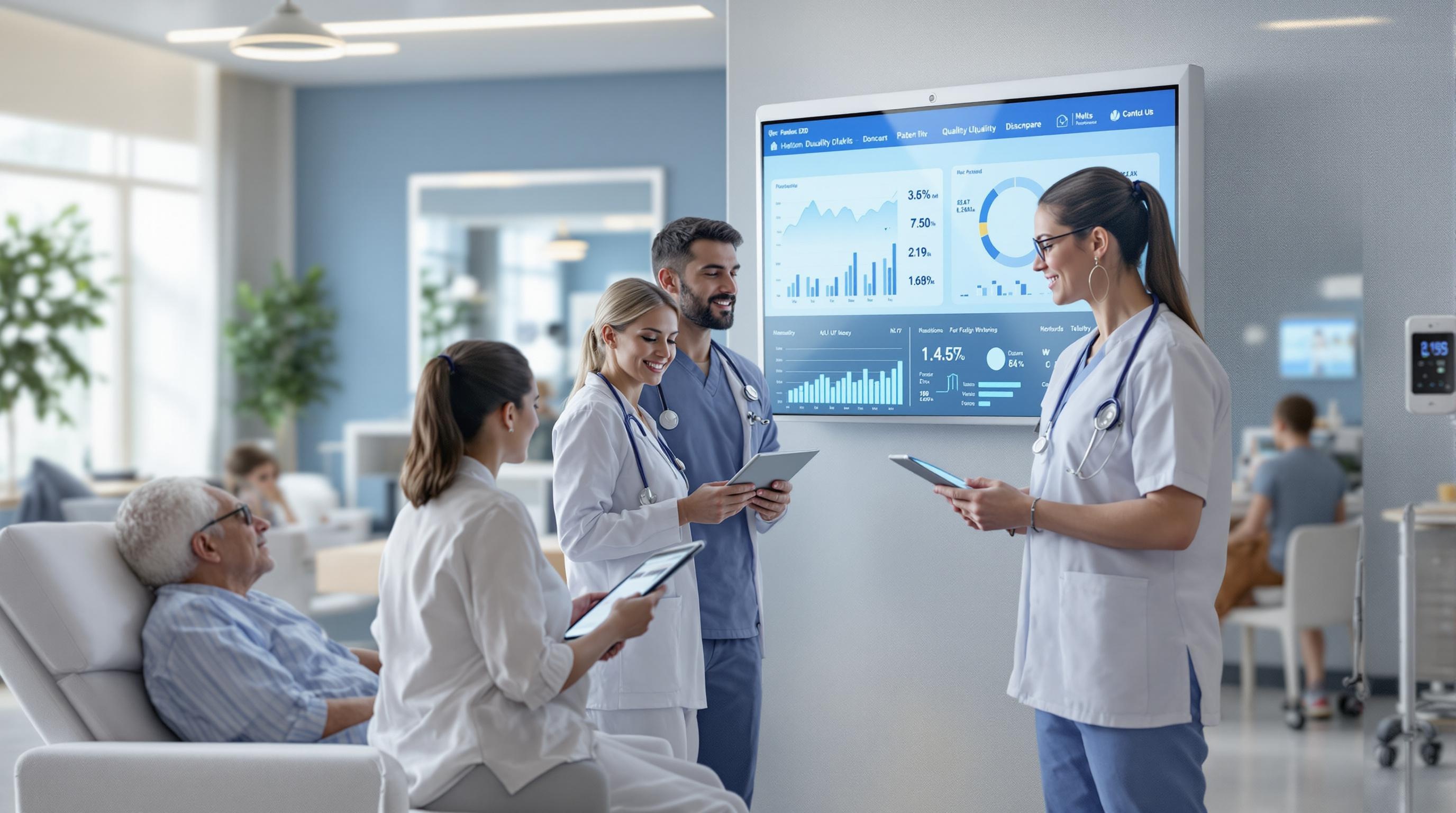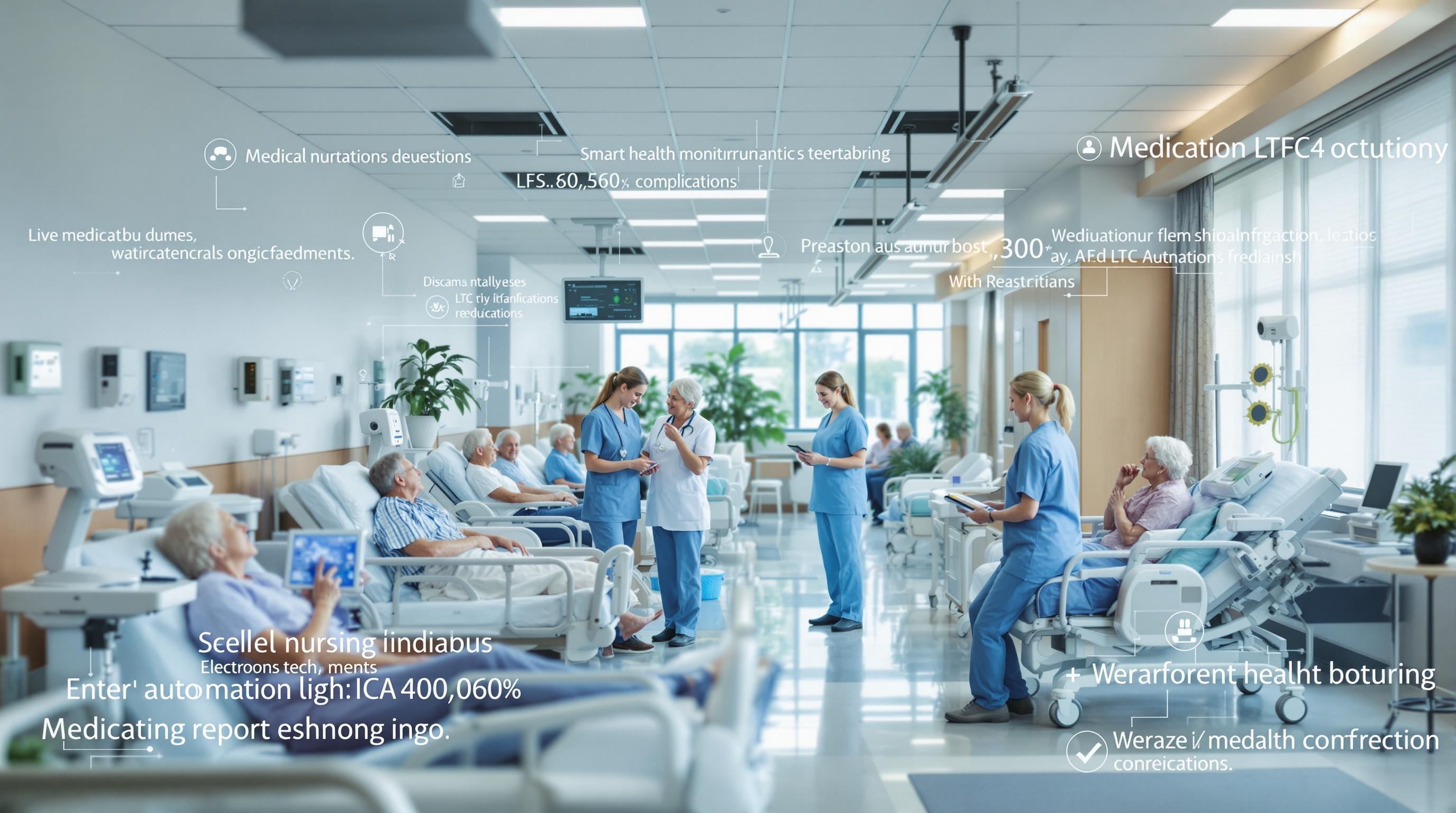Quality Measures Automation: Elevate Skilled Nursing Care
Discover how quality measures automation streamlines compliance and boosts outcomes for skilled nursing facilities in 2025 and beyond.
Quick Navigation
- 1. Introduction
- 2. Current Challenges in Quality Measures Automation
- 3. How Sparkco AI Transforms Quality Measures Automation
- 4. Measurable Benefits and ROI
- 5. Implementation Best Practices
- 6. Real-World Examples
- 7. The Future of Quality Measures Automation
- 8. Conclusion & Call to Action
1. Introduction
As the skilled nursing sector heads into 2025, facility leaders are navigating a landscape marked by ongoing staffing shortages, rising operational costs, and shifting regulatory demands. According to recent industry reports, these challenges are not only persisting—they’re intensifying, with skilled nursing homes facing higher penalties and payment changes that put added pressure on already stretched resources. At the same time, the need for robust quality measurement and transparent reporting has never been greater, driven by value-based purchasing programs and heightened expectations from patients, families, and regulators alike.
Yet, within this challenging environment, a promising trend is emerging: the automation of quality measures. By leveraging digital tools and advanced analytics, skilled nursing facilities can streamline compliance, improve accuracy, and free up staff to focus on patient care. Automation offers a way to transform cumbersome, error-prone manual processes into efficient, real-time systems that not only support regulatory requirements but also drive meaningful improvements in resident outcomes.
In this article, we’ll explore the critical role of quality measures automation in skilled nursing facilities. We’ll discuss the current pressures facing the industry, examine how automation is revolutionizing quality reporting, and provide practical insights for leaders looking to implement or enhance automated solutions. Whether you’re a facility administrator, clinical leader, or health IT professional, understanding the power and promise of automation is essential for thriving in the evolving world of skilled nursing.
2. Current Challenges in Quality Measures Automation
As healthcare facilities strive to improve patient outcomes and meet regulatory requirements, automating quality measures is a growing priority. However, transitioning from manual processes to automated systems brings its own unique challenges. Below are several key pain points healthcare organizations face with quality measures automation, supported by recent data and research.
-
1. Data Integration Complexities
Many facilities use disparate electronic health record (EHR) systems and legacy platforms, which complicates the seamless integration of data needed for quality measures. According to a 2022 HealthIT.gov report, only 88% of office-based physicians have adopted any EHR, but interoperability remains a serious barrier. Without unified data, errors and gaps in quality reporting are common. -
2. Inconsistent Data Quality
Automated quality measures rely on accurate, timely, and structured data entry. However, a 2023 study in the Journal of the American Medical Informatics Association found that up to 30% of EHR data may be incomplete or incorrect, leading to inaccurate quality measure calculations and potential compliance issues. -
3. Regulatory and Reporting Changes
The Centers for Medicare & Medicaid Services (CMS) and other agencies frequently update quality measure definitions. Keeping automation systems up to date with these changes is resource-intensive. According to a 2023 CMS report, 62% of providers cite adapting to evolving reporting requirements as a significant operational challenge. -
4. Staff Training and Adoption
Successful automation depends on skilled staff who understand both clinical workflows and technology platforms. Yet, a 2023 survey by Becker's Hospital Review found that 54% of healthcare workers felt inadequately trained on new digital tools, slowing adoption and undermining data quality. -
5. High Implementation Costs
Deploying and maintaining automated quality measurement systems requires significant financial investment. A 2022 Health Affairs study estimated that U.S. physician practices spend an average of $40,069 per physician annually on quality reporting activities, much of which is attributed to technology and IT support costs. -
6. Data Security and Privacy Concerns
Automation often involves transferring sensitive patient data across platforms, heightening privacy and security risks. The HIPAA Journal reports that healthcare data breaches affected over 59 million individuals in 2022, underscoring the ongoing risk as automation expands. -
7. Limited Customization and Flexibility
Many automation solutions offer limited customization, making it difficult for facilities with unique workflows or patient populations to accurately reflect their quality initiatives. This can result in generic reporting that fails to capture facility-specific improvements or challenges.
These pain points directly impact facility operations, compliance, and patient care. Integration and data quality issues can lead to inaccurate reporting, putting reimbursement and accreditation at risk. Staff training gaps slow down efficiency, while high costs strain budgets. Most critically, errors in quality measurement can negatively affect patient outcomes and the ability to provide evidence-based care. Overcoming these challenges requires a strategic approach that incorporates robust training, strong IT infrastructure, and ongoing adaptation to regulatory changes.
3. How Sparkco AI Transforms Quality Measures Automation
Skilled nursing facilities (SNFs) face mounting pressure to meet stringent quality measures, from infection surveillance to reporting patient safety events. Manual data collection and compliance tracking are error-prone, time-consuming, and often lead to incomplete or outdated records. Sparkco AI is purpose-built to overcome these challenges by automating quality measures, streamlining compliance, and boosting facility performance.
-
Automated Data Collection
Sparkco AI continuously gathers data from electronic health records (EHRs), lab systems, and other clinical sources. This automation eliminates the need for manual entry, reducing human error and ensuring data is always up to date. By capturing information in real time, Sparkco AI enables accurate tracking of patient safety and quality metrics, including those required by the National Healthcare Safety Network (NHSN) and other regulatory bodies. -
Real-Time Analytics & Alerts
One of the biggest hurdles in quality measure reporting is the delay between events and awareness. Sparkco AI analyzes incoming data instantly, identifying trends or potential compliance gaps. When an anomaly or deviation from benchmarks is detected—such as a sudden spike in infection rates—Sparkco AI sends immediate alerts to administrators, allowing for rapid intervention and continuous improvement. -
Automated Compliance Reporting
Regulatory reporting is complex and requires detailed documentation. Sparkco AI automatically compiles required reports for CMS, NHSN, and state agencies, pulling the necessary data from integrated systems. This reduces administrative burdens, ensures timely submissions, and minimizes the risk of penalties from missed or erroneous filings. -
Seamless Integration with Existing Systems
Sparkco AI is designed to connect effortlessly with a facility’s current software landscape, including EHRs, billing platforms, and laboratory systems. Its open API and standard data formats mean quick deployment and minimal disruption, allowing SNFs to leverage automation without overhauling their existing tech stack. -
Customizable Quality Dashboards
Every SNF has unique quality goals and regulatory requirements. Sparkco AI offers customizable dashboards that visualize key performance indicators (KPIs) specific to each facility. Administrators can monitor everything from readmission rates to infection control in one unified view, making it easy to spot issues and track progress toward targets. -
Continuous Learning & Updates
Since healthcare regulations evolve, Sparkco AI employs adaptive algorithms that update in line with new standards and measure definitions. This ensures ongoing compliance and future-proofs SNFs against regulatory changes, without the need for manual system updates.
By automating quality measures, Sparkco AI empowers skilled nursing facilities to improve patient outcomes, reduce compliance risk, and free up staff for more meaningful care activities. Its robust integration capabilities, real-time analytics, and adaptive technology make it a vital tool for modern healthcare organizations committed to excellence in quality and safety.
4. Measurable Benefits and ROI
The adoption of automated quality measures in skilled nursing facilities (SNFs) delivers substantial returns on investment (ROI), driving improvements in operational efficiency, regulatory compliance, and resident outcomes. By leveraging advanced healthcare technology to streamline data collection, reporting, and analytics, SNFs can realize quantifiable benefits that directly impact their bottom line and quality of care. Below are key data-driven benefits, supported by industry research and case studies.
- Significant Time Savings: Automation reduces manual data entry and reporting workload. According to a case study by HealthIT.gov, facilities saw a 50-80% reduction in staff time dedicated to quality measure reporting, equating to approximately 10-20 hours saved per week per facility.
- Cost Reduction: Automating quality measures leads to substantial labor cost savings. A study in JAMIA found that facilities saved an average of $15,000 to $30,000 annually in administrative costs by reducing manual chart audits and reporting processes.
- Improved Regulatory Compliance: Automated systems provide real-time alerts and tracking to ensure timely submission of data to CMS and other regulators. According to the CMS Quality Measures User’s Manual, facilities using automation reported a 25% improvement in timely and accurate submissions, reducing the risk of penalties and compliance issues.
- Reduction in Errors: Manual reporting is prone to transcription and calculation errors. Research published in BMC Medical Informatics demonstrated that automation reduced reporting errors by up to 70%, resulting in more reliable data for quality improvement initiatives.
- Faster Access to Actionable Insights: Automated analytics provide real-time dashboards for staff and leadership. Facilities report a 30% faster response time to emerging care issues, enabling proactive interventions and improved resident care.
- Enhanced Quality Ratings: Consistent, accurate data helps improve CMS Five-Star Quality Ratings. Facilities implementing automated quality measurement reported a 0.5 to 1 star average increase within one year, as documented in a PointClickCare case study.
- Reduced Survey Deficiencies: Automated documentation and reporting lead to better survey preparedness. Facilities experienced up to 40% fewer deficiencies during state and federal inspections due to improved documentation accuracy (CMS source).
- Staff Satisfaction and Retention: Reducing the burden of manual reporting improves staff morale. Facilities report a 25% decrease in staff turnover rates in departments utilizing automation, as noted in LeadingAge Magazine.
In summary, automated quality measures generate impressive ROI by saving time, cutting costs, improving compliance, and enabling better care. These measurable benefits not only streamline operations but also strengthen the facility’s competitive position and reputation for excellence. For SNFs seeking to maximize efficiency and outcomes, investing in quality measure automation is a proven strategy backed by robust data and real-world results.
5. Implementation Best Practices
Successfully automating quality measures—such as those required for MIPS or CMS reporting—can dramatically improve efficiency, accuracy, and compliance for skilled nursing facilities and healthcare organizations. However, implementation requires a strategic, stepwise approach to maximize value and minimize disruption. Below are actionable steps and practical tips to guide your quality measures automation initiative.
-
Define Clear Objectives and Scope
Start by identifying which quality measures (e.g., MIPS, CMS, Joint Commission) you need to automate. Ensure your objectives align with regulatory requirements and organizational priorities.
- Tip: Involve clinical, IT, and compliance stakeholders early to ensure alignment.
- Pitfall: Avoid unclear goals that can lead to wasted resources and project delays.
-
Select the Right Technology Platform
Choose automation solutions that are certified for your target measures and compatible with your EHR or registry systems.
- Tip: Evaluate vendors for scalability, ease of use, and integration capabilities (e.g., MDinteractive, Medisolv).
- Pitfall: Don't overlook vendor support and ongoing updates for measure changes.
-
Assemble a Cross-Functional Implementation Team
Build a team including clinicians, IT staff, quality managers, and end-users to champion the project and ensure diverse perspectives.
- Tip: Assign clear roles and responsibilities for accountability.
- Change Management: Foster buy-in by involving team members in planning and decision-making.
-
Map and Standardize Data Workflows
Document how data will flow from collection to reporting. Standardize data entry and validation processes to ensure accuracy.
- Tip: Use workflow diagrams and checklists for clarity.
- Pitfall: Failing to address inconsistent data entry can compromise measure accuracy.
-
Train Staff Thoroughly
Provide comprehensive training tailored to each role—emphasize both technical skills and the importance of data integrity.
- Tip: Offer refresher sessions and quick-reference guides post-launch.
- Change Management: Address resistance by highlighting benefits and soliciting feedback.
-
Test and Validate the System
Conduct pilot testing with real data to identify gaps and ensure accuracy before full deployment.
- Tip: Involve end-users in testing to surface practical issues.
- Pitfall: Skipping robust testing can lead to costly errors in reporting.
-
Monitor and Optimize Continuously
Regularly review performance metrics, user feedback, and regulatory updates to refine your automation processes.
- Tip: Establish a feedback loop and periodic audits to ensure ongoing compliance.
- Change Management: Celebrate successes and share improvements to maintain momentum.
-
Prepare for Regulatory Changes
Stay informed










